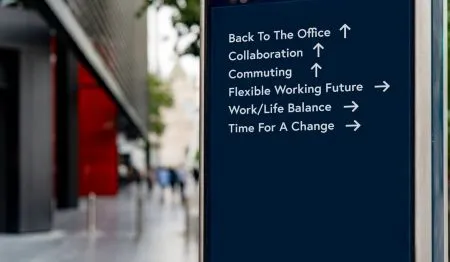Increasing flexible working arrangements has become a significant trend in modern workplaces. This trend is driven by many factors such as technology advancements and changing attitudes towards work-life balance. Furthermore, there’s now widespread recognition of the benefits flexible working provides both employers and employees.
Many professionals look to employers who offer job flexibility to enhance their work-life balance and for more freedom. As working full-time, juggling personal commitments, and finding a work-life balance can be a challenge.
Why should you offer more flexibility in the workplace?
Businesses who offer flexibility to their staff receive many benefits as a result. Benefits of flexibility in the workplace for employers include:
- Happier and more productive employees
- Increased staff retention
- Helps you when recruiting, as your company will look more attractive to potential employees.
Comments on flexibility from our Recruitment Consultants
Attraction and Retention of Talent
Offering flexible working arrangements can make your company more attractive to prospective employees and can also help retain current staff members. Many job seekers prioritise flexibility when considering potential employers, and employees are more likely to stay with a company that offers and reviews their flexibility options. – Nikki Phillips, Senior Recruitment Consultant covering all legal roles across North West England and Wales.
Increasing flexibility in the workplace can also encourage greater diversity across many different metrics including gender, ethnicity and disability. There are numerous people who struggle with full-time, in office work. For example, for caregivers or those who can’t drive due to a medical condition. If you are struggling to attract a diverse talent pool, then look at your flexibility and ask yourself if you could do more. – Amy Watson, Director and Recruitment Consultant covering all legal roles across North East England and Yorkshire.
Ways to offer more flexibility
Here are several strategies and options for increasing flexible working:
Flexible working hours
There are many ways to be flexible over working hours. Consequently, moving away from the traditional 9am to 5pm can open up many hiring opportunities.
Flexitime
Flexitime is great, for when people are working extra hours and you don’t pay overtime. It allows them to take the time back to support their work-life balance. If people are expected to work additional hours and they aren’t compensated for them, after a while it will begin to grate on them and negatively impact their work-life balance. For example, if people are working overtime to meet deadlines or travelling to visit clients, they could take the time back at quieter times.
Core Hours
Core hours work by having set hours that must be worked during the day and offering flexibility outside of core hours. If employees are working their contracted hours it is another way to provide extra flexibility. For example, if your core hours are 10am-2pm, your employees have the flexibility to start and finish work outside of those hours. Maybe starting earlier working longer hours one day and finishing earlier another day.
Four day working week
A four-day working week is still being trialled across the globe. The majority of companies who took part in the initial trial have implemented a four day working week permanently. These companies noticed an increase in productivity and a positive impact on their employees’ wellbeing.
In our exclusive interview with John Hopkins – a leading expert in flexible working research – he discusses his findings from interviews with employers who have introduced a four day working week. Click here to read the full interview.
Prioritise Health and Well-being
Encouraging employees to prioritise their health and wellness can lead to increased productivity and job satisfaction. Implement wellness programs that support employee well-being, such as onsite fitness classes, mindfulness sessions, or access to mental health resources.
Provide flexibility for health appointments
It’s hard arranging health appointments when you work full time Monday to Friday. So, by being flexible and allowing employees to have health appointments during working hours, takes some stress and worry away from them when they are ill. Getting the help they need when ill to recover is better than not getting help and their work suffering as a result.
Caregiving Leave
Offering caregiving leave establishes your company as compassionate and opens your firm up to a new group of hires. Sometimes things happen that are unexpected and can’t be planned for, which your employers might benefit from taking extra leave off for. By offering caregiving leave, it will make your firm accessible as an employer for people with children, or planning to have children or people with elderly relatives who need care.
Buy and Sell Leave
Offering employees the opportunity to buy and sell leave gives them more flexibility for big life events. It allows them to effectively manage their work-life balance giving them more freedom over their leave entitlement.
Work from anywhere policy
A work from anywhere policy gives your employees extra flexibility over their working location. We have a policy where our employees can work from anywhere in the world for 5 days a year outside of their contracted location of office / hybrid or homeworking.
Hybrid working
2020 showed that many people can work from home efficiently and effectively. Consequently, hybrid working has become increasingly popular in recent years. Many people haven’t wanted to return to the office full-time and hybrid working offers them the best of both worlds. Working from home a day or two a week improves their work-life balance with no commute, saving time and commuting costs. Whilst working in the office provides time for communicating and collaborating face-to-face with colleagues.
With employees’ preferences changing, offering hybrid working will increase talent pools when hiring and enhance staff retention.
Advice for implementing a flexible working strategy
Eventus Legal as it was then, was set purely on a flexible basis long before it was the norm and it has been in practice for us since, whether that is genuine hybrid working, reduced hours or flexibility to work around families. Here, from our experience we provide our top tips for implementing flexible working policies.
Consult with your employees
It’s important to consult with all your employees before implementing flexible working policies. Flexible working expert John Hopkins said in an exclusive interview with us, that: “before changing anything, it’s important that employers understand the needs of their workers. What kinds of flexibility they would value, and how they will benefit from having it? This is a great starting point for implementing any new workplace flexibility measures. It is essential that workers are consulted in the first instance like this, before discussing what might be possible and what the benefits would be.”
Performance Metrics
Change how you measure performance. Shift the focus from hours worked to outcomes achieved. Establish clear goals and performance metrics for employees, which can be measured without considering their working hours or location.
Invest in technology
Invest in software that enables remote communication, teamwork and task management. This includes technology like video conferencing, project management software, and cloud-based document sharing software.
Management Training
Provide training and guides to all managers on any flexible working policies you introduce. Training should include how to implement the arrangements, communicating the policy, making adjustments, monitoring performance and requesting feedback.
Regularly review policy
It’s important that you regularly request feedback from managers and employees and review flexible working policies. This is to ensure that the arrangements are still working from both a business perspective and they are meeting your employee’s requirements.
Trial Periods
When introducing flexible working arrangements, consider holding a trial period to assess the feasibility and address any challenges before committing long-term.
By implementing this advice, businesses can effectively increase flexible working arrangements, promoting employee well-being, productivity and retention.


